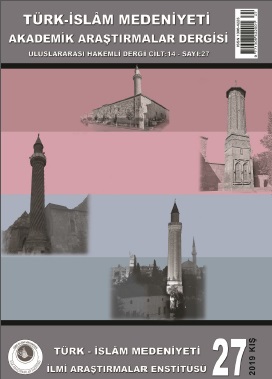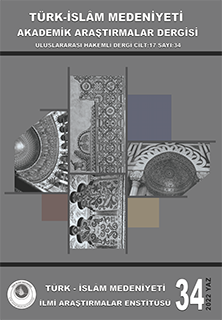Ekber-Name’de Alan-go’a Efsanesinin Yeniden Yorumlanması
Anahtar Kelimeler:
Alan-go’a, Ekber Şah, Babür İmparatorluğu, Timuriler, Moğollar, Karizmatik LiderlikÖzet
Alan-go’a, yüzyıllar boyunca Orta Asya’da hükümdar olma ayrıcalığını elinde tutan Cengiz Han’ın Altın Soyunun (Altan Uruğ) efsanevi ata anasıdır. Hindistan’da kurulan Babür İmparatorluğunun üçüncü hükümdarı olan Ekber Şah da Alan-goa’nın kendi atası olduğunu ileri sürdü. Bu iddiayı, kendisinin Cengizliler ile olan Akrabalık bağına dayanarak ortaya koymadı. Aksine, Alan-go’a’nın var oluş nedeninin kendisinin ilahi bir varlık olarak Dünya’ya gelmesi olduğunu ve Cengizlilerin ve diğerlerinin hükmünün kendisi Dünya’ya gelinceye kadar bittiğini ileri sürdü; bu amaçla Alan-go’a hikâyesini sufi mistik bir açıdan İmparatorluğu içinde bulunan farklı dini-kültürel değerlere göre yeniden yorumlattı. Böylece, kendisine gösterişli bir karizma oluşturarak, hakimiyeti altında bulunan farklı dini-kültürel ve etnik özellikler gösteren topluluklara gücünün ve otoritesinin meşruluğunu kabul ettirmeyi amaçladı. Ayrıca, Ekber Şah Alan-go’a efsanesi üzerinden, atası olarak gördüğü Timurileri ve kendi soyundan gelenleri, Cengizlilerden ve Dünya’nın bütün hanedanlıklarından üstün olduğu iddiasında bulundu. İşte bu makalede, Alan-go’a efsanesi Cengizli ve Timurlu gelenek ile karşılaştırılarak, bu efsanesinin Ekber Şah sarayında niçin ve nasıl yeniden şekillendirildiği sorularına cevap aranacaktır.
Referanslar
ABU’L FAZL ALLAMI, 2000 (1907), The Akbar Nama of Abu-l-Fazl, translated: H. Beveridge, Low Price Publications, New Delhi.
ALAM, M., 2004, The Language of Political Islam; India 1200-1800, Hurst&Company, London.
ANOOSHAHR, A., 2012, “Dialogism and Territoriality in a Mughal History of the Islamic Millennium,” Journal of Social and Economic History of Orient, volume:55, Number:2/3, p.220-254.
BALABANLILAR, L., 2016, Memory and Dynastic Politics in Early Modern South and Central Asia; Imperial Identity in the Mughal Empire, I. B. Tauris.
BEVERIDGE, H., 1912 (1986), A Comprehensive History of India, volume:I With an
introduction of J.P. Gulo, Associated Publishing House New Delhi-110005.
DALKESEN, N., 2012, ”The Cult of Alan-gho’a and Unique Position of Women in the Chinggisid Dynasties”, Proceedings of Hsiung-nu Empire and the Study of Ancient Mongolian History Conference, Mongolian Academy of Science, Ulanbaatar, p.388-398.
FLEISCHER, C., 1986, Bureaucrat and Intellectual in the Ottoman Empire; The Historian Mustafa Âli (1541-1600), Princeton University Press.
FOLTZ, R., 1997, “Central Asians in the Administration of Mughal India,” Journal of Asian History, Volume:31, number: 2, p.139-154.
, 1998, “Cultural Contacts between Central Asia and Mughal India”, Central Asiatic Journal, volume:42, number:1, p. 44-65.
HUSAIN, A., 1971, “Marriages among Mughal Nobles as an Index of Status and Aristocratic Integration”, Proceedings of the Indian History Congress, volume:33,p.304-312.
JORDENS, J. T. F., 1999, (Third. Ed.), “Medieval Hindu Devotionalism”, A Cultural History of India, edited: A. L. Basham, Oxford Univ. Press, p. 266-280.
DICKSON, M., 1958, Shah Tahmasb and the Ozbeks, Published Phd. Dissertation Thesis, Princeton University.
KHAN, I.A., 2001, “State in the Mughal India: Re-examination of the Myths of a Countervision”, Social Scientist, volume:. 30, number:1-2, January-February, p.16-37.
HODGSON, M., 1974, Venture of Islam, Conscience and History in a World Civilization; The Gunpowder Empires and Modern Times, volume: 3, University of Chicago press, Chicago & London.
KAFALI, M., “Timur,” in İA (MEB), volume: 12/1, s.336.
KHANDMIR, 1342/1963-64, Giyas el-Din, Ḥabib al-Siyar fi Akhbar-i Afrad-i Bashar, Vol.3, edited: Jalāl al-Din Huma’i and Muhammad Dabir-Siyaqi, Intisharat-I Khayyam, Tehran.
KOLF, D. H. A., 1998, “A Warlord’s Fresh Attempt at Empire,” in the Mughal State 1526-1750, edited: Muzaffar Alam and Sanjay Subrahmanyam, Oxford Univ. Press.
LAL, R., 2001, “Settled, Sacred and All-Powerful; Making of new Geneologies and Traditions of Empire under Akbar”, Economic and Political Weekly, volume:36, number:11, March 17-23, p.941-958.
MANZ, B. F., 1996, The Rise and Rule of Tamerlane, Cambridge Univiversity Press, Cambridge.
O’HANLON, R., 2007, “Kingdom, Household and Body History, Gender and Imperial Service under Akbar”, Modern Asian Studies, volume: 41, number: 5, p. 889-923.
RACHEWILTZ, I., 2015, The Secret History of the Mongols: A Mongolian Epic Chronicle of the Thirteenth Century, (shorter version), Edited: Western Washington University.
RASHID AL-DIN, Fazlullah, 1387, Cami al-Tavarikh, der Tarikh-i Moghul, Edited: Behmen Kerimi, Ekbal, Tehran.
RICHARDS, J. F., 2000, The formulation of Imperial Authority under Akbar and Jahangir, “The Mughal State 1526-1750”, edited: Muzaffar Alam and Sanjay Subrahmanyam, Oxford University Press, p.126-167.
RIZVI, S.A.A., 1999, The Muslim Ruling Dynasties, “A Cultural History of India”, Edited: A. L. Basham, Oxford University Press, p. 239-265.
ROGERS, J. M., 1995, Mughal Miniatures, British Museum Press, London.
STREUSAND, D.E., 2011, Islamic Gunpowder Empires, Ottomans, Safavid and Mughals, Westview Press.
SUBTELNY, M. E., 2007, Timurids in Transition; turko-Persian Politics and Acculturation in Medieval Iran, Brill.
TAPAR, R., 1990, A History of India, volume:I, Penguin Books, London.
SKRYNNIKOVA, T. D., 2010, Rivalary between mongols and Tayići’ut for Authority: Kiyat-Borjigin Genealogy, “Representing power in ancient Inner Asia: Legitimacy, Transmission and The Sacred”, Edited: Isabelle Charleux, Gregory Delaplace, Roberte Hamayon and Scott Pearce. Center for East Asian Studies, Western Washington University, p.6-18.
TOGAN, Z. V., 1970, Umumi Türk Tarihine Giriş, Enderun Yayınları, İstanbul.
WEBER, M., 1978, Economy and Society - An Outline of Interpretive Sociology, University of California Press, New York, Berkeley, Los Angeles.
WOODS, John,1990, Timur’s Geneology, “Intellectual Studies on Islam. Essays Written in Honor of Martin B. Dickson”, University of Utah Press, Salt Lake City, p.88-125.
ZIEGLER, N., 1978, Some Notes on Rājpūt Loyalties during the Mughal Period, “Kingship and authority in South Asia”, Edited: J. F. Richards, Univ. of Wisconsin South Asian Studies, Madison, p.215-251.
İndir
Yayınlanmış
Nasıl Atıf Yapılır
Sayı
Bölüm
Lisans

Bu çalışma Creative Commons Attribution-NonCommercial 4.0 International License ile lisanslanmıştır.







